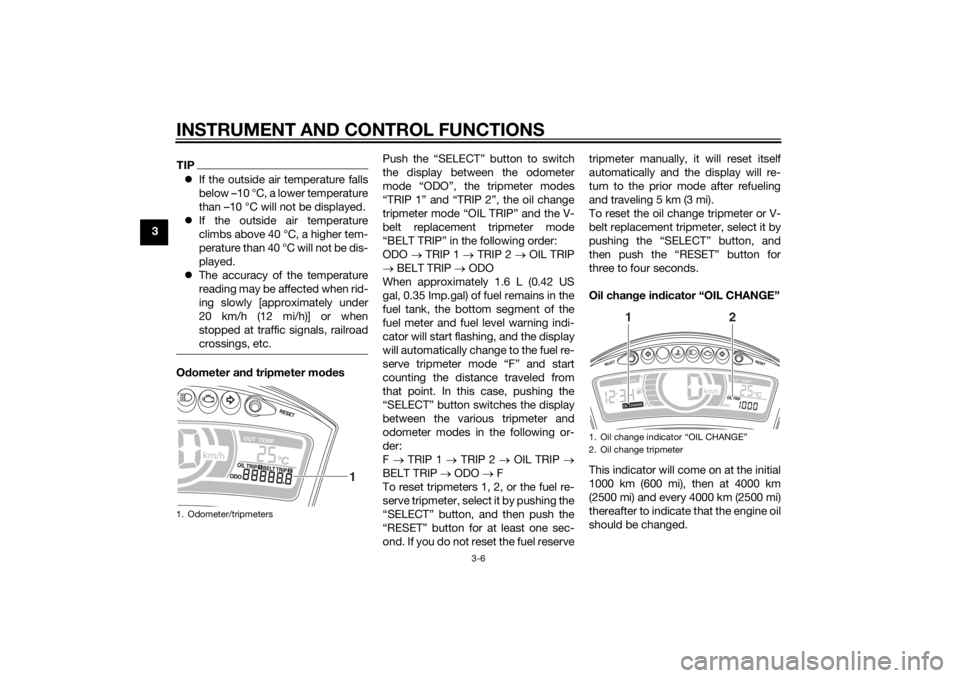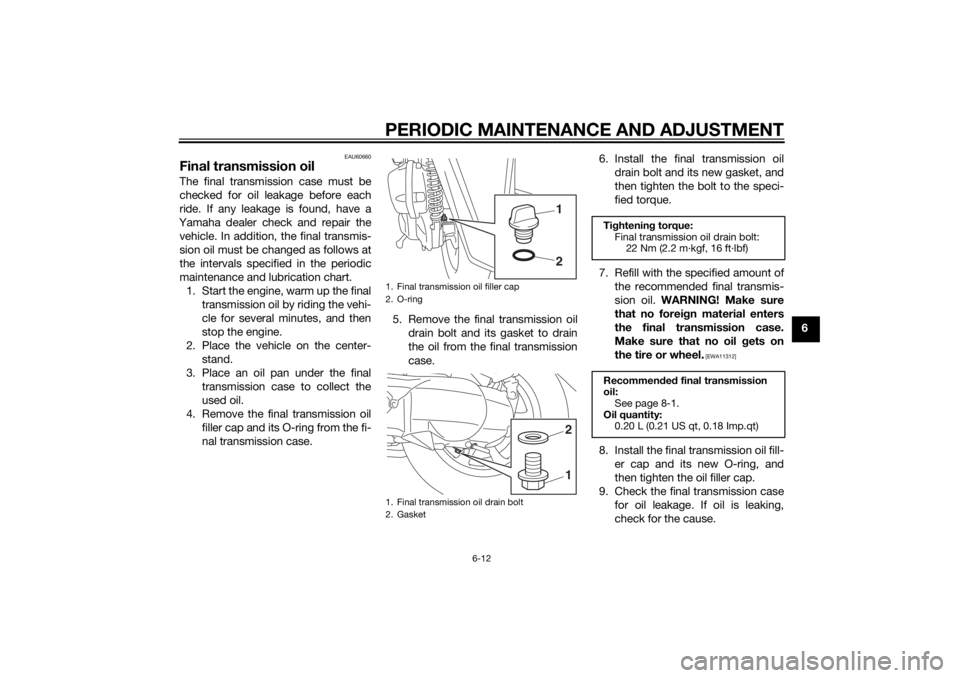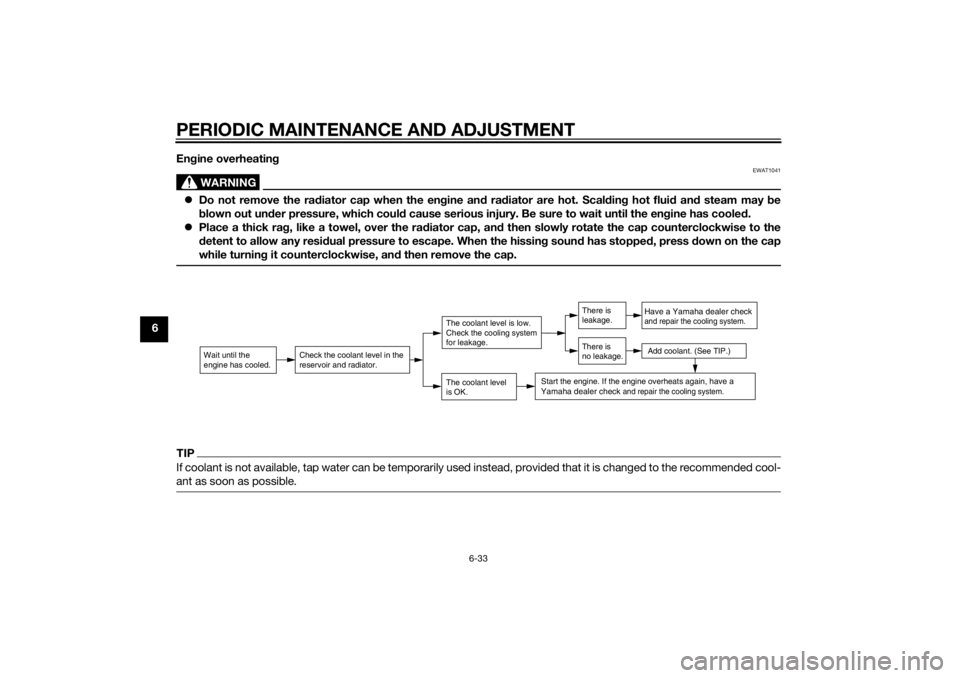Page 22 of 84

INSTRUMENT AND CONTROL FUNCTIONS
3-6
3
TIPIf the outside air temperature falls
below –10 °C, a lower temperature
than –10 °C will not be displayed.
If the outside air temperature
climbs above 40 °C, a higher tem-
perature than 40 °C will not be dis-
played.
The accuracy of the temperature
reading may be affected when rid-
ing slowly [approximately under
20 km/h (12 mi/h)] or when
stopped at traffic signals, railroad
crossings, etc.Odometer an d tripmeter mo des Push the “SELECT” button to switch
the display between the odometer
mode “ODO”, the tripmeter modes
“TRIP 1” and “TRIP 2”, the oil change
tripmeter mode “OIL TRIP” and the V-
belt replacement tripmeter mode
“BELT TRIP” in the following order:
ODO
TRIP 1 TRIP 2 OIL TRIP
BELT TRIP ODO
When approximately 1.6 L (0.42 US
gal, 0.35 Imp.gal) of fuel remains in the
fuel tank, the bottom segment of the
fuel meter and fuel level warning indi-
cator will start flashing, and the display
will automatically change to the fuel re-
serve tripmeter mode “F” and start
counting the distance traveled from
that point. In this case, pushing the
“SELECT” button switches the display
between the various tripmeter and
odometer modes in the following or-
der:
F TRIP 1 TRIP 2 OIL TRIP
BELT TRIP ODO F
To reset tripmeters 1, 2, or the fuel re-
serve tripmeter, select it by pushing the
“SELECT” button, and then push the
“RESET” button for at least one sec-
ond. If you do not reset the fuel reserve tripmeter manually, it will reset itself
automatically and the display will re-
turn to the prior mode after refueling
and traveling 5 km (3 mi).
To reset the oil change tripmeter or V-
belt replacement tripmeter, select it by
pushing the “SELECT” button, and
then push the “RESET” button for
three to four seconds.
Oil chan
ge in dicator “OIL CHANGE”
This indicator will come on at the initial
1000 km (600 mi), then at 4000 km
(2500 mi) and every 4000 km (2500 mi)
thereafter to indicate that the engine oil
should be changed.1. Odometer/tripmeters
1
1. Oil change indicator “OIL CHANGE”
2. Oil change tripmeter
1
2
U2CME0E0.book Page 6 Friday, May 2, 2014 2:55 PM
Page 36 of 84

OPERATION AND IMPORTANT RIDING POINTS
5-1
5
EAU15952
Read the Owner’s Manual carefully to
become familiar with all controls. If
there is a control or function you do not
understand, ask your Yamaha dealer.
WARNING
EWA10272
Failure to familiarize yourself with
the controls can lead to loss of con-
trol, which coul d cause an acci dent
or injury.
EAU45311
TIPThis model is equipped with a lean an-
gle sensor to stop the engine in case of
a turnover. To start the engine after a
turnover, be sure to turn the main
switch to “OFF” and then to “ON”. Fail-
ing to do so will prevent the engine
from starting even though the engine
will crank when pushing the start
switch.
EAU60631
Startin g the en gineNOTICE
ECA10251
See pag e 5-3 for en gine break-in in-
structions prior to operatin g the ve-
hicle for the first time.In order for the ignition circuit cut-off
system to enable starting, the side-
stand must be up. See page 3-15 for more information. 1. Turn the key to “ON”. The following warning lights
should come on for a few sec-
onds, then go off. Engine trouble warning light
Coolant temperature warning
lightNOTICE
ECA15485
If a warnin g li ght does not come on
initially when the key is turned to
“ON”, or if a warnin g li ght remains
on, see pa ge 3-2 for the correspon d-
in g warnin g li ght circuit check.2. Close the throttle completely.
U2CME0E0.book Page 1 Friday, May 2, 2014 2:55 PM
Page 51 of 84

PERIODIC MAINTENANCE AND ADJUSTMENT
6-12
6
EAU60660
Final transmission oilThe final transmission case must be
checked for oil leakage before each
ride. If any leakage is found, have a
Yamaha dealer check and repair the vehicle. In addition, the final transmis-
sion oil must be changed as follows at
the intervals specified in the periodic
maintenance and lubrication chart. 1. Start the engine, warm up the final transmission oil by riding the vehi-
cle for several minutes, and then
stop the engine.
2. Place the vehicle on the center- stand.
3. Place an oil pan under the final transmission case to collect the
used oil.
4. Remove the final transmission oil filler cap and its O-ring from the fi-
nal transmission case. 5. Remove the final transmission oil
drain bolt and its gasket to drain
the oil from the final transmission
case. 6. Install the final transmission oil
drain bolt and its new gasket, and
then tighten the bolt to the speci-
fied torque.
7. Refill with the specified amount of the recommended final transmis-
sion oil. WARNING! Make sure
that no forei gn material enters
the final transmission case.
Make sure that no oil gets on
the tire or wheel.
[EWA11312]
8. Install the final transmission oil fill- er cap and its new O-ring, and
then tighten the oil filler cap.
9. Check the final transmission case for oil leakage. If oil is leaking,
check for the cause.
1. Final transmission oil filler cap
2. O-ring
1. Final transmission oil drain bolt
2. Gasket
1
212
Tightenin g torque:
Final transmission oil drain bolt: 22 Nm (2.2 m·kgf, 16 ft·lbf)
Recommen ded final transmission
oil: See page 8-1.
Oil quantity: 0.20 L (0.21 US qt, 0.18 Imp.qt)
U2CME0E0.book Page 12 Friday, May 2, 2014 2:55 PM
Page 72 of 84

PERIODIC MAINTENANCE AND ADJUSTMENT
6-33
6En
gine overheatin g
WARNING
EWAT1041
Do not remove the ra diator cap when the en gine an d ra diator are hot. Scal din g hot flui d an d steam may be
b lown out un der pressure, which coul d cause serious injury. Be sure to wait until the en gine has coole d.
Place a thick ra g, like a towel, over the ra diator cap, an d then slowly rotate the cap counterclockwise to the
d etent to allow any resi dual pressure to escape. When the hissin g soun d has stoppe d, press d own on the cap
while turnin g it counterclockwise, an d then remove the cap.TIPIf coolant is not available, tap water can be temporarily used instead, provided that it is changed to the recommended cool-
ant as soon as possible.
Wait until the
engine has cooled.
Check the coolant level in the
reservoir and radiator.
The coolant level
is OK.The coolant level is low.
Check the cooling system
for leakage.
Have a Yamaha dealer checkand repair the cooling system.Add coolant. (See TIP.)
Start the engine. If the engine overheats again,
have a
Yamaha dealer check
and repair the cooling system.
There is
leakage.
There is
no leakage.
U2CME0E0.book Page 33 Friday, May 2, 2014 2:55 PM